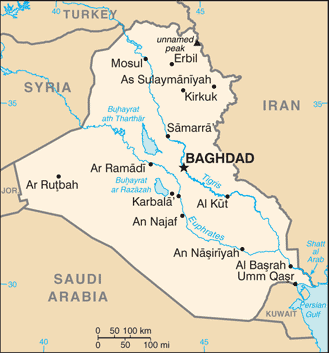Three live, off-air, recordings of the clandestine Voice of Free Iraq on 6 January 1991 beginning at 14:27 UTC on a shortwave frequency of 17960 kHz (about 28 minutes in length), on 18 January 1991 beginning at 03:28 UTC on 9565 kHz (about 4 minutes in length), and on 3 February 1991 beginning at 18:55 UTC (about 30 minutes in length). The Voice of Free Iraq began broadcasting programs on 1 January 1991 using one medium wave (1053 kHz) and three shortwave frequencies (approximately 9565 kHz, and 15600 and 17940 kHz initially, shifting later to 17960 kHz) contributed by the radio services of Syria, Egypt, Saudi Arabia, and the Gulf Co-operation Council states. A fourth frequency was subsequently added: 9995 kHz. The station likely broadcast from one or more of those countries. According to the New York Times, a studio was located in Jeddah, Saudi Arabia. The station identified as "Idha'atu-l-gumburiya al-'iraqiyya min Baghdad - Saut al-Iraq Al-Hurr." According to newspaper accounts, the station may have been financed by the U.S. Central Intelligence Agency.
Reception of the three broadcasts varied.
For the broadcast on 6 January 1991, reception, including the initial transmitter tune-up tone, was fairly good. However, at about 14:51 UTC, about 23 minutes into the recording, an Iraqi wideband "bubble" jammer starts up on the frequency. A few minutes later, an oscillating tone is added to the jammer. In the recording, an attempt to monitor the other frequencies of 15600 and 9570 kHz can be heard. 15600 kHz is subsequently jammed.
For the broadcast of 18 January 1991, there is no apparent jamming. Quite possibly, by this time, either Iraq's jamming facilities had been put out of action either directly by coalition bombing of transmitter sites or by attacks on the electrical grid. There is some slight interference and a heterodyne tone.
Similarly, for the broadcast of 3 February, no jamming can be heard. However, there is some fading of the signal and there are periods of local interference towards the end of the recording. It was noticed that the signal on 17960 kHz was in parallel to 9570 kHz. A couple of hours later, the broadcast was also noted on 9995 kHz.
The broadcasts were received in Hanwell, New Brunswick, Canada, using a Sony ICF-7600D receiver and supplied wire antenna draped around the listening room.






















